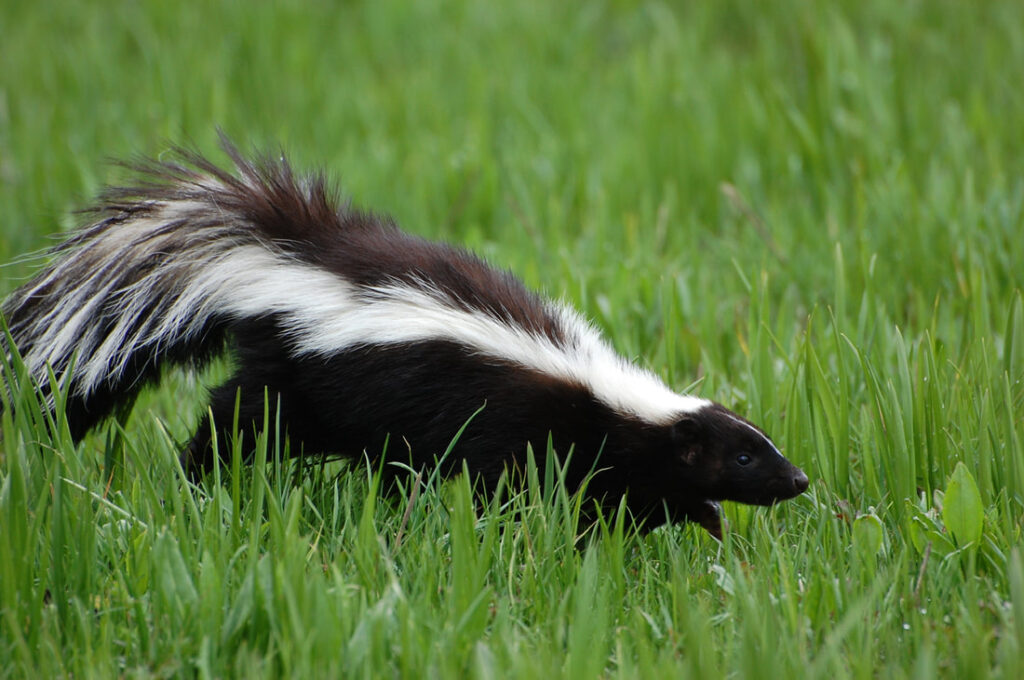There are many interesting facts about skunks, including their instantly recognizable black-and-white fur pattern. It turns out that a skunk’s stripes are not merely decorative but also serve an important purpose.
Why Do Skunks Have Stripes?
Aposematism is a distinctive colouration that sends a warning to a potential predator letting them know that the animal is not good to eat. A skunk’s dramatic black-and-white markings are visible even to animals that cannot perceive colour. Getting sprayed by a skunk is an unforgettable experience even after the odour fades, which can take days or even weeks. An animal that has had a confrontation with a skunk before will do whatever it takes to avoid repeating the experience. Aposematism helps a skunk warn predators off without having to use its spray. This is important because a skunk’s body needs time to produce more fluid after it has sprayed. The process can take up to 10 days, during which time the skunk is vulnerable to attack.
The striped skunk is the most common skunk species in North America. It has two long stripes that start at its head and travel down its back in a V-shape. Some scientists believe that the stripes not only serve as a general warning to predators but they actually point toward a skunk’s most effective weapon. The skunk’s fluid is secreted by two glands on either side of its anus, which is approximately where the stripes point. The striped skunk also has a small, thin stripe on its nose that may point at its mouth. Skunks can bite in self-defence, but their spray is so effective at deterring predators that it usually isn’t necessary.
Do All Skunks Have Stripes?
All skunks have some form of distinctive black-and-white coloration that can follow different patterns depending on the species. For example, the hooded skunk has one large white stripe that starts at its head and extends down the back and over its tail. The white fur of the hooded skunk tends to be longer than its black fur.
While the striped skunk has unbroken white stripes, the spotted skunk has white markings that generally follow a stripe pattern, but they are broken up by black so that the white markings look like spots, hence its name.
When Do Skunks Get Their Stripes?

One of the most incredible skunk facts is that their markings are present in their skin from the time that they are born, but because skunks are born without hair, the markings are hard to see at first. The areas of skin where the black fur will grow may be a little darker than the areas of eventual white fur, but the difference is subtle and hard to see. Once their fur starts growing in, which happens within approximately the first two weeks of life, their markings become easier to see.
Where Do Skunks Live on Your Property?
Knowing how to get rid of a skunk requires figuring out where it is hiding. Skunks are burrowing animals, and only one species is able to climb, so if a skunk is on your property, you will almost certainly find it close to the ground. Skunks like to find a sturdy, solid structure that provides protection and dig a burrow underneath. For example, you may find that a skunk has dug a hole underneath a shed. Skunks may also look for the abandoned burrow of another animal to make a den. If you have an outdoor space that looks similar to an abandoned burrow, such as the space underneath a deck or porch, a skunk may turn it into a den.
Why Should You Call Skedaddle for Skunk Removal in Richmond Hill?
Attempts to remove skunks from your property yourself could cause you to be sprayed at best and bitten at worst. Our technicians remove skunks safely and clean up any lingering odour. We seal known and potential entryways. Learn more about our skunk removal process in Richmond Hill.



